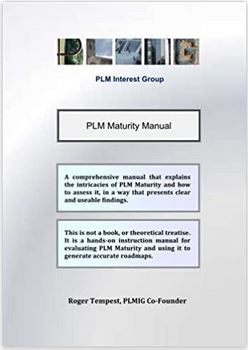|
PLM Interest Group |
|||||||||||||||||||||||
|
|
|
|
|||||||||||||||||||||
|
|
|
|||||||||||||||||||||
|
|
|
|
|||||||||||||||||||||
|
PLM Maturity Manual
The PLM Maturity Manual contains the most complete and advanced framework for classifying and assessing PLM Maturity. It overturns vague notions of a "Level 1-5" maturity score by showing the full details of PLM maturity, enabling you to produce accurate spreadsheets and charts that build into a Roadmap for your PLM implementation. What the Maturity Manual Does
The Version 3.0 Maturity Manual acts as a textbook to define what "Maturity" is in PLM terms, and describes how you can use this in your own environment as a tool for roadmapping and target setting. The Manual has a clear structure in four main parts, designed to take the user through the subject in the most logical way.
The aim of a PLM Maturity Assessment is to give a clear and informative picture of current PLM progress, and to show the way forward towards Full Maturity. For this reason, a Maturity Assessment is also an essential Step in the Class A PLM programme. Why This Manual is Different
There are some well-known definitions and scoring systems for Maturity, most of which have been designed for other disciplines. They do not work well when applied to PLM. There are two main reasons for this. One is that their choice of Levels from 1 to 5 is inaccurate; and the other is that they aim to provide only a single maturity score for the whole assessment. PLM is far too complex for this. A conventional choice of maturity levels may include headings such as "Repeatable | Defined | Managed". However, in real PLM implementations, 'Managed' may happen before anything is properly defined in writing; and 'Repeatable' may happen after that. Therefore, a PLM assessment with this type of heading may show higher levels happening before lower levels - or produce a maturity score that is at two different levels simultaneously. The PLM Maturity Manual uses a Scale calibrated specifically for PLM. Conventional methods tend to yield an overall score for Maturity, but this is not sufficient for PLM. You need to know the Perimeter of Interest (the scope of the assessment); and the score must be subdivided for the PLM elements of Data | People | Processes | Technology | Knowledge. This extra level of detail is essential for an accurate understanding of PLM Maturity, and it provides the PLM Team with a much greater level of analysis. Accurate Maturity Assessment
The PLM Maturity Manual was first published in 2007 based on a 3-day PLMIG workshop in Paris, at which PLM practitioners worked through the subject and generated the detailed structure. It has been extensively updated at Version 3.0, with new material that assists the PLM Manager to process the results into a clear written report. This written structure enables many stakeholders to take part in the Assessment, and presents the findings in a way that is understandable and informative. The scoring system is consistent and repeatable, enabling comparisons across different parts of the business; and is scaleable to the entire enterprise. Advanced Roadmapping
There is a general concept of a "roadmap" as a "sort of Strategic Plan". The PLM Maturity Manual is much more advanced than this. The Manual contains a complete section on Roadmapping, explaining how to incorporate one or many Maturity Assessment Reports into a stand-alone PLM Roadmap Document that becomes the central reference for long-term PLM planning. The Roadmap is not a single picture. It consists of several elements:-
Using the Maturity Manual
The PLM Maturity Manual can be used for initial fact-finding, one-off Assessments, or enterprise-wide maturity management. By appropriate selection of the Assessment Axes and the Perimeter of Interest it can generate a detailed and accurate maturity picture for different parts of the business or for different aspects of PLM. The documentation structure instils a natural sense of discipline to the investigations and makes for easy dissemination of the findings. The scores and the GAP Analysis clearly illustrate the progess and potential of PLM, and by sensible updating and revisioning of the PLM Roadmap Document, year-on-year planning can be focused on the optimal areas for improvement. How Do I Get One?
The PLM Maturity Manual is provided with Q&A support to PLMIG Members, so you will receive a copy if you join with any class of Membership. Alternatively, you may buy hard copies from Amazon or electronic copies from the Store. For more information about PLM Maturity, or the Manual itself, contact maturity@plmig.com. © Copyright 2025 PLM Interest Group |
||||||||||||||||||||||
| <<< Return Home | |||||||||||||||||||||||
|
|
|
|
|||||||||||||||||||||
|
|
|||||||||||||||||||||||





